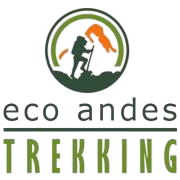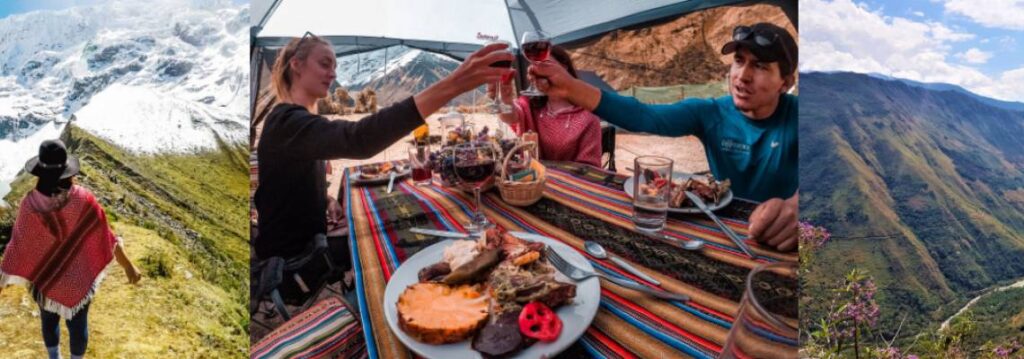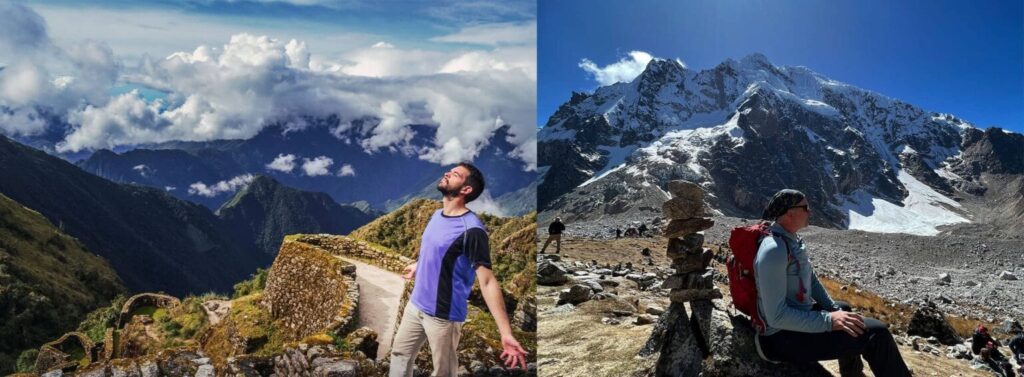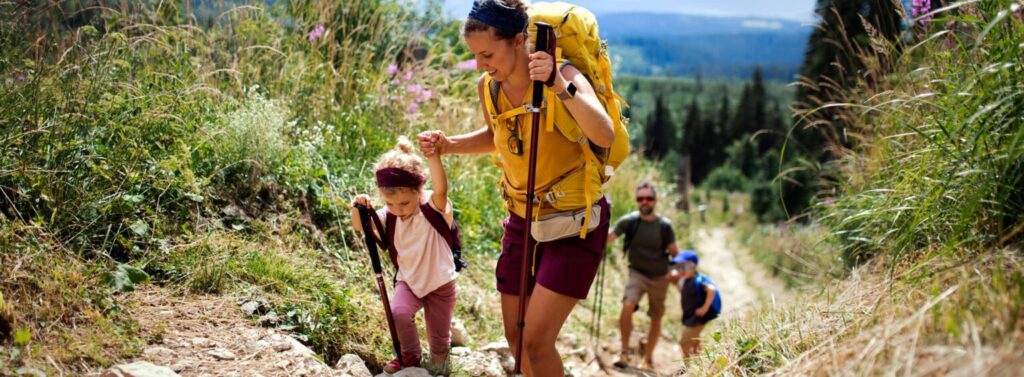
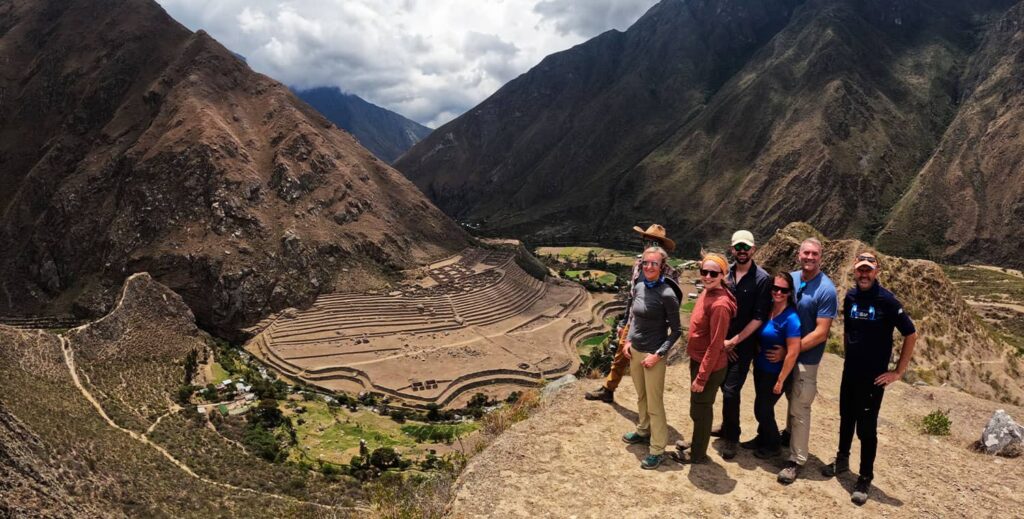
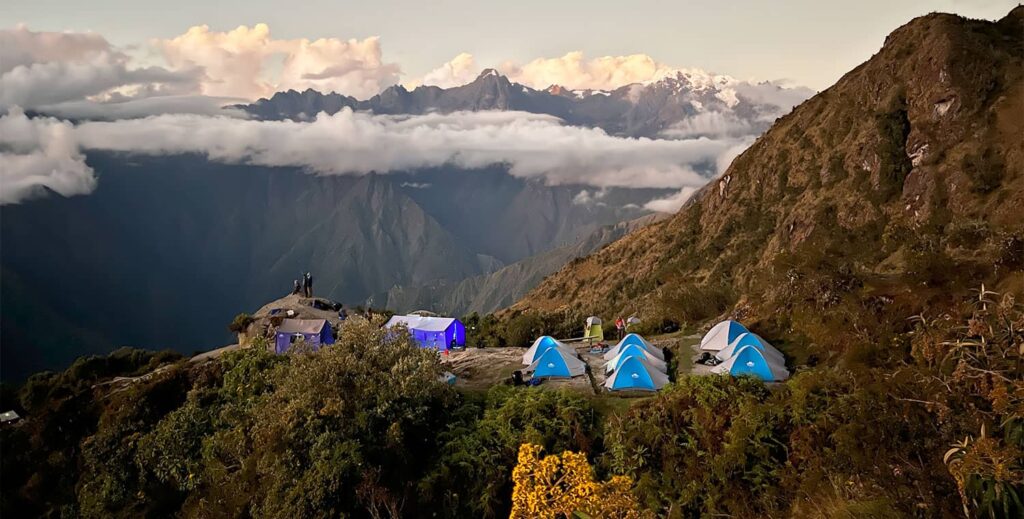
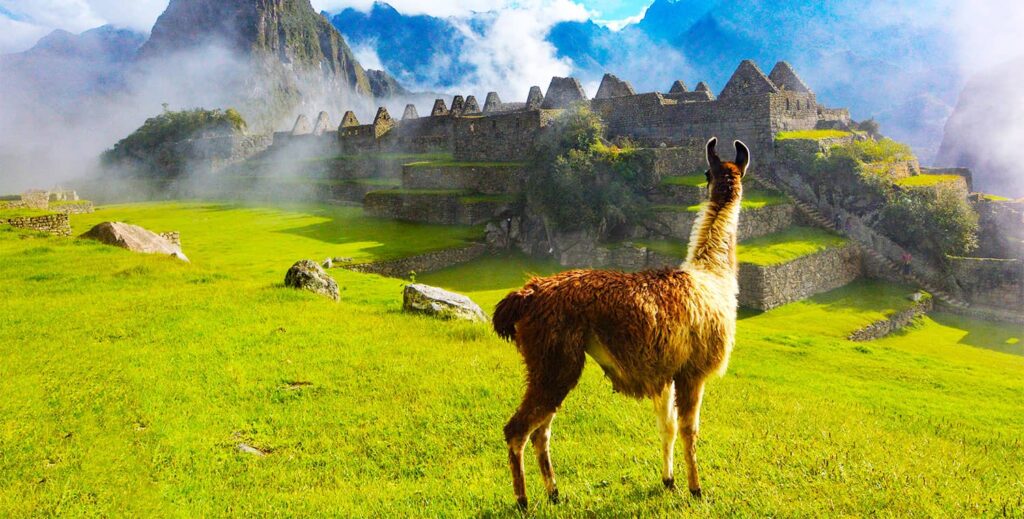
Premium Inca Trail to Machu Picchu – 5D/4N
Embark on our one-in-a-lifetime 5-day Inca Trail Trek to Machu Picchu. Discover ancient ruins, lush landscapes, and cultural wonders. Book now!
Are you ready to push your limits and experience the magic of Machu Picchu in the most authentic way?
Look no further than our premium Inca Trail trek.
This 5-day, 4-night adventure is designed to challenge your body and spirit while rewarding you with unparalleled views and unforgettable memories.
About our Premium Inca Trail tour

The iconic Inka Trail to Machu Picchu is a journey of challenge and wonder.
Spanning altitudes from lush valleys (2,700 m/8,856 ft) to breathtaking mountain passes (4,215 m/13,825 ft), this 5-day, 4-night Premium Inca Trail trek offers the most authentic path to the Lost City of the Incas.
Experience the thrill of trekking along original Inca pathways, an extensive tour of Machu Picchu, and explore spectacular ruins tucked within the Andes.
Each day presents new and immersive encounters with ancient history, guided by our expert team with a passion for Inca culture.
Hike alongside fellow explorers, forge unforgettable memories, and conquer a bucket list trek on this life-changing expedition.
This experience doesn’t just culminate in a Machu Picchu hike, it elevates the whole experience.
We’ll include deluxe accommodations on the final night, along with a celebratory dinner at Aguas Calientes’ finest restaurant. Plus, a ticket to ascend Huayna Picchu mountain to check out some unparalleled views.
Not ready for 5 days? Check out our Classic Inca Trail 4-day trek to Machu Picchu here.
ITINERARY – PREMIUM INCA TRAIL TREK TO MACHU PICCHU
Pre-trek briefing (required):
Before we set off, we’ll need to have a chat about what you can expect, cover some ground rules, and of course, give you an opportunity to bring up any questions you have about the itinerary or otherwise.
You can either choose to visit us at our office for this briefing, or we’ll come to you at your hotel in Cusco.
Note: Your briefing must happen the day before the Inca Trail trek begins, so make sure you give yourself enough time when booking travel over to Cusco.
Day 1: Cusco to KM 82 and onward to Hatunchaca
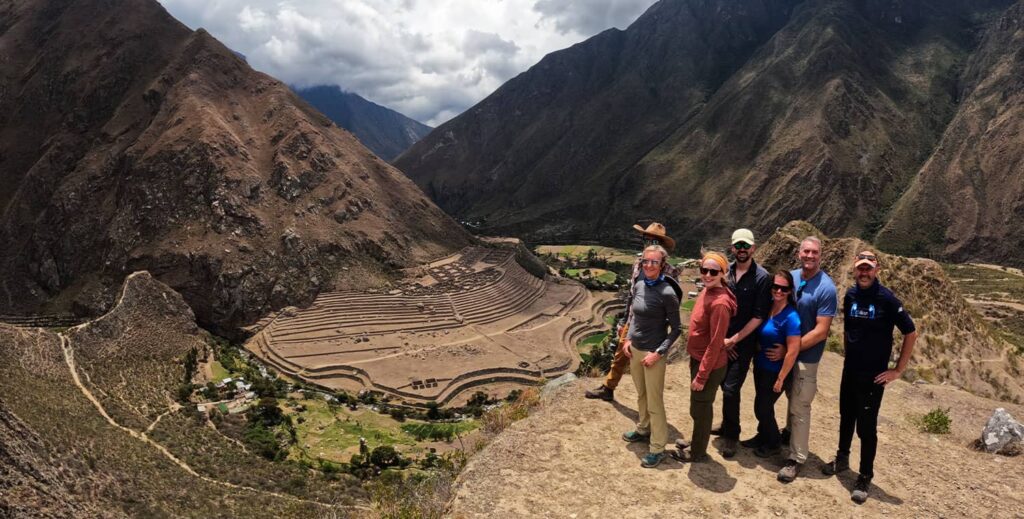
We’ll ease into this Inca Trail adventure nice and smooth, kicking off at a relaxed pace to get you warmed up for the days ahead.
Our journey begins at Kilometer 82, where we’ll stroll along the banks of the mighty Urubamba River with the snow-capped giant Mount Veronica towering over us. Keep your eyes peeled as you go – the native plants and birds will be putting on quite the show!
Then it’s on to the little town of Miskay before an easy two-hour uphill stretch towards the awe-inspiring ruins of Llactapata.
You’ll have a chance to check out this ancient Inca city (aka Patallacta) – one of the most famous archeological sites on this route.
It’s made up of platforms, channels, stairways and other small enclosures, all beautifully conserved. The Inca Trail is the only way that visitors can see the wonder of Llactapata up close, and it truly is a once in a lifetime sight to behold.
After refueling with a hearty lunch next to these ancient stones, we’ll mosey on down to Hatunchaca Camp for the night.
By camping a bit further along than most groups, we’ll be setting ourselves up nicely for tomorrow’s hike over the first mountain pass.
- Meals: Lunch/Dinner
- Distance Covered: 10 km/6 miles
- Approximate Walking Time: 5-6 hours
- Lowest elevation: 2,600 m/8,525 ft
- Highest elevation: 2,950 m/9,676 ft
- Difficulty: Moderate
Day 2: Great to Little
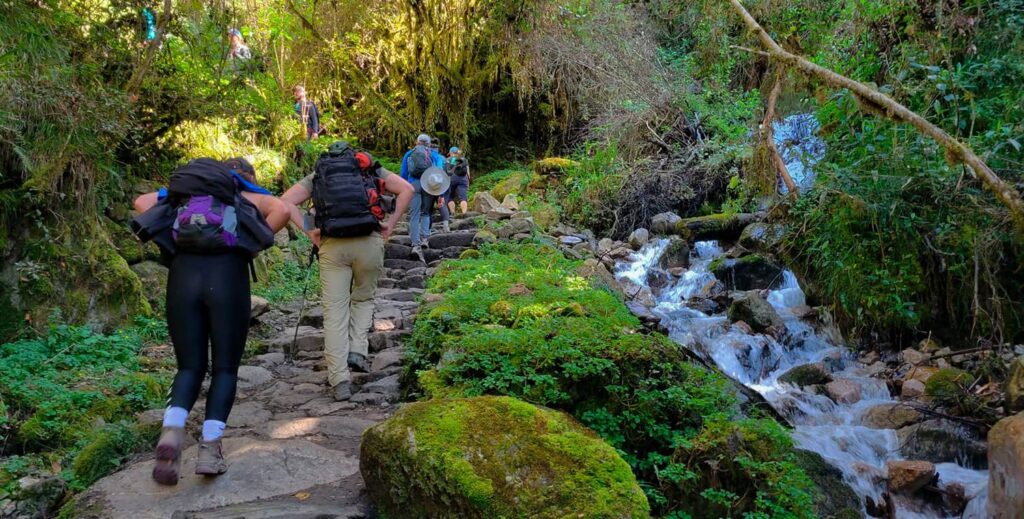
Today’s trek is a nice, gentle warm-up before we take on Dead Woman’s Pass tomorrow – the highest point of our whole adventure.
Tonight, we’ll bed down at Llulluchapampa Camp, right at the base of that big climb. This strategic stopover lets us split the toughest section into two days, making that mountain seem a little less daunting.
As we make our way to Llulluchapampa, we’ll take a detour to visit the rarely-seen Inca fort of Tarahuasi – an off-the-beaten-path treat.
We’ll be treated to some jaw-dropping scenery, from lush forests to soaring peaks. Who knows, we might even catch a glimpse of some white-tailed deer frolicking amid all the amazing plants and birdlife.
- Meals: Breakfast/Lunch/Dinner
- Distance Covered: 9 km/5.5 miles
- Approximate Walking Time: 5 hours
- Lowest elevation: 2,950 m/9,676 ft
- Highest elevation: 3,800 m/12,460 ft
- Difficulty: Moderate
Day 3: Llulluchampampa to Phuyupatamarca
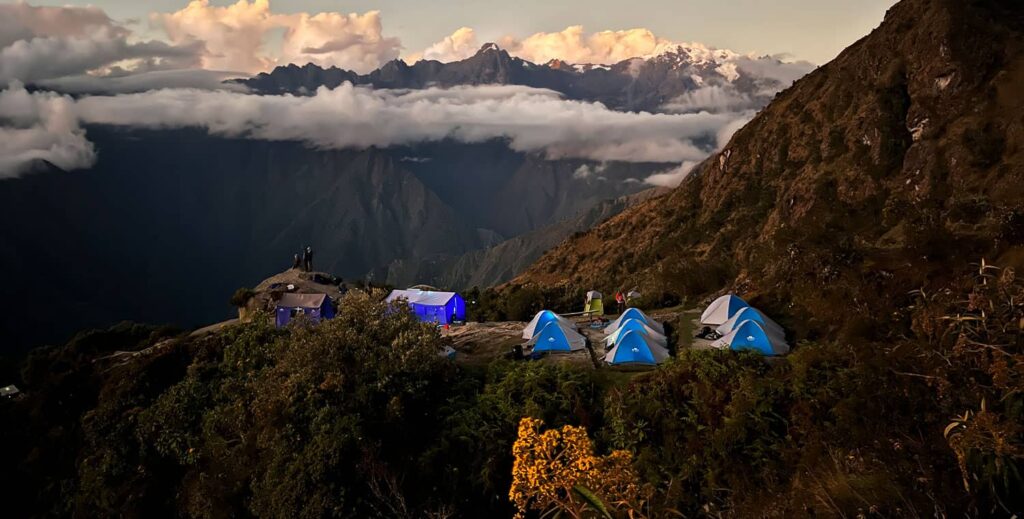
Time to dig deep! We’ve got two high passes to conquer today.
Llulluchapampa Camp put us right at the base of the first big one – Dead Woman’s Pass.
After kicking that challenge’s butt, we’ll press on over Runcuraccay Pass. And the reward? An easy, flat-out gorgeous hike surrounded by towering, snow-capped peaks that’ll take your breath away.
In between passes, we’ll explore two mind-blowing Inca sites – Runcuraccay and Sayacmarca.
Tonight, we’ll be bunking down at Phuyupatamarca Camp where we’ll get our first tantalizing peek at the iconic Machu Picchu Mountain off in the distance.
The big finale is just around the corner!
- Meals: Breakfast/Lunch/Dinner
- Distance Covered: 15 km/9.5 miles
- Approximate Walking Time: 8 hours
- Lowest elevation: 3,680 m/12,073 ft
- Highest elevation: 4,215 m/13,825 ft
- Difficulty: Challenging
Day 4: Phuyupatamarca to Eternal and Machu Picchu
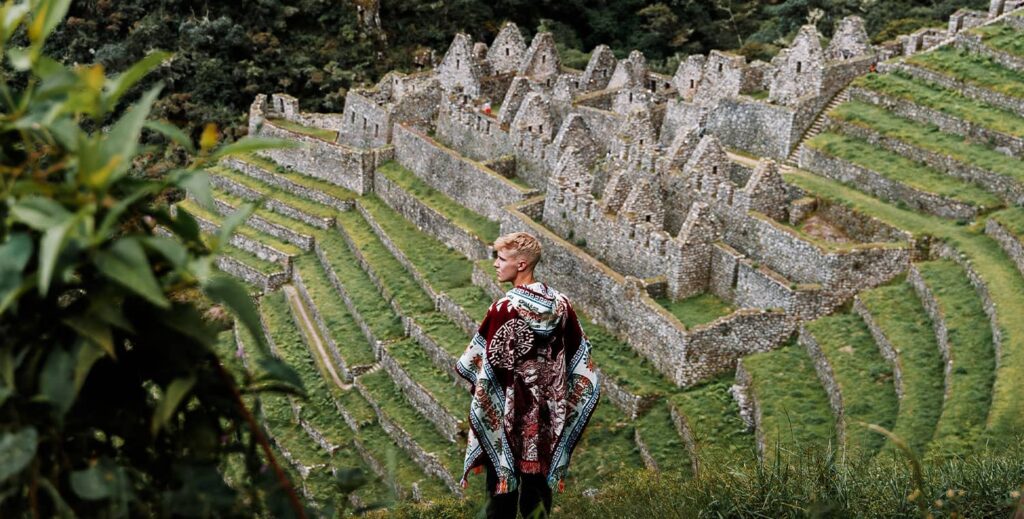
Today we’ll visit the epic sites of Phuyupatamarca, Intipata and Wiñay Wayna before finally – finally! – making our way towards the one and only Machu Picchu.
In the late afternoon, we’ll arrive at the Sun Gate for that iconic first glimpse that’ll drop your jaw right to the floor. From there, it’s downhill to the cute little town of Aguas Calientes where we’ll check into a cozy three-star hotel.
Be sure to take advantage of the local hot springs before dinner – the perfect way to soothe those hard-working muscles.
- Meals: Breakfast/Lunch/Dinner
- Accommodations: Bed and breakfast
- Distance Covered: 11 km/7 miles
- Approximate Walking Time: 5 hours
- Lowest elevation: 2,040 m/6,691 ft
- Highest elevation: 3,680 m/12,073 ft
- Difficulty: Moderate
Day 5: Aguas Calientes – Machu Picchu – Cusco

On our final day, we’ll rise and shine early to witness the sublime Machu Picchu sunrise – a scene you’ll never forget.
Once the ruins have been bathed in that golden morning light, the real exploring will happen, beginning with a two-hour guided tour.
(And for those of you adrenaline junkies who booked it, there’s also the chance to scale the heights of Huayna Picchu Mountain).
Once we’ve had our fill of Machu Picchu majesty, it’s back to Aguas Calientes. From there, we’ll take a scenic train ride to Poroy or Ollantaytambo followed by a private van back to Cusco. and get you settled comfortably at your hotel – the perfect ending to this epic Inca Trail adventure!
Throughout our five days trekking, you’ll have expert guides, hardworking porters and staff, top-notch meals, cozy camping and lodging, comprehensive site tours, and all the group fees covered including Inca Trail permits and Machu Picchu entrance.
- Meals: Breakfast
- Minimum altitude: 2,040 m/6,691 ft
- Maximum altitude: 2,440 m/8,052 ft
What’s Included in The Premium Inca Trail to Machu Picchu Package?
- Your own personal trekking superhero – a professional, licensed guide who’s fluent in English, Spanish, and Quechua. For larger groups, we’ll even hook you up with an assistant guide.
- A pre-trek briefing 1-2 days before we hit the trails to get you fully prepared.
- A whole team of rockstar support staff – professional chefs and porters to carry all the group gear and supplies.
- A Personal porter to carry eight kg (15 pounds) of your own belongings.
- Your sleeping bag and mattress will count towards this weight limit. Approximate weight of the average sleeping bag and sleeping mattress is 3 kg.
- Meals: Four delicious breakfasts, lunches, and dinners prepared fresh by our talented chefs. Snacks and drinking water to fuel you.
- Hot water for washing up each day – gotta stay fresh on the trails!
- A full suite of camping luxuries: dining tent with tables, stools, dishes, a private toilet tent, and kitchen tent. Cozy sleeping tents and mattresses with 4 person tents for every pair.
- One night’s stay in a comfortable, quality hotel in Aguas Calientes with double occupancy rooms.
- Emergency supplies galore: first aid kit, oxygen, emergency radios – we’ve got your back!
- All group fees taken care of – Inca Trail permits, Machu Picchu entrance, you name it.
- Train ticket from Aguas Calientes to Ollantaytambo on Day 5.
- All transfers covered: private van to the trailhead at KM 82, bus from Machu Picchu to Aguas Calientes, and a private van back to your Cusco hotel when we return.
- For the daredevils, a ticket to climb Huayna Picchu
NOT included:
- Sleeping Bag – can be rented from us
- Trekking Poles – can be rented from us.
- Breakfast on Day 1 and lunch on Day 5
- Tips for porters, chef, and guide
Items to bring with you:
- Original passport (if you have acquired a new one after you made your booking, bring both)
- Down or synthetic feather sleeping bag (can be rented from us)
- Clothes (trekking boots, warm fleece jacket, a few T-shirts, socks, sun hat, warm underwear, light long pants, gloves, rain jacket)
- Toiletries (toilet paper, wet wipes, personal towel)
- Sunscreen (SPF 35+ recommended)
- Headlamp, batteries*
- Sunglasses
- Camera with spare batteries*
- Binoculars
- Book to read (you will have some spare time at every camp)
- Trekking poles (recommended especially for the steep descents, can be rented from us. Must have rubber tips)
- Insect repellent
- NOTE: Batteries run down faster at high altitudes
PRICES & ADD-ONS
Group: USD $1080 per person
Private: USD $1150 per person
Group versus Private Treks: What’s the difference?
- Depending on the number of people in your booking, additional people may join the trek to make a full group.
- If you choose “private”, no additional people will be joining your group, no matter the size.
- Minimum booking size is two people; one person may book a group trek if Eco Andes Trekking is able to join that person with additional groups.
Discounts
- Under 18 years Discount: USD $20
- Under 7 years Discount: USD $35
Rentals
- Hiking poles – USD $25 (pair) per person
- Sleeping bag – USD $30 per person
Upgrades
- Return Vistadome train – USD $60 per person
- Return Hiram Bingham train– USD $420 per person
- Sumaq Machu Picchu Hotel (5-star hotel) – USD $255 Per person per night (double occupancy)
- Inkaterra El Pueblo Machu Picchu Hotel (5-star hotel) – USD $250 Per person per night (double occupancy)
- El Mapi Hotel by Inkaterra (4-star hotel) – USD $115 Per person per night (double occupancy)
- Tierra viva Machu Picchu (3+ star hotel) – USD $50 Per person per night (double occupancy)
- Private Tent – USD $40 per person
PREMIUM INCA TRAIL 2025 FAQs.
What is the Premium Inca Trail Trek to Machu Picchu?
The Premium Inca Trail is a well-established 5-day, 4-night hike which leads travelers from km.82 (start of the Inca Trail) all the way to one of the famous new seven wonders of the world, Machu Picchu via its iconic Sun Gate.
This version of the trek is ideal for families with kids and photographers. You move at a slightly slower pace while you follow the trail as the classic 4-day Inca Trail trek. You will stop at alternative campsites to avoid the crowds and have more time to enjoy the scenery, giving you the opportunity to see more of the sites along the way as well as two visits to Machu Picchu!
Our Premium Inca Trail trek also gives you a night at a hotel in Aguas Calientes so you can shower and clean up for a second visit to Machu Picchu on day five.
The good news is that it’s a lot shorter than you may expect at only 45 kms (28 miles). The bad news? A significant chunk of that 45 kms is up steep, narrow Andean Mountain paths at altitude.
The Incan Empire created thousands of kilometers of trails to link its important settlements and centers of civilization, but it is this specific Inca Trail trek which is known as the one and only traditional Inca Trail trek to Machu Picchu.
Why the Inca Trail is so popular?
The Trail is a microcosm; lush green cloud forest alive with birds, Andean peaks and steep mountain passes, a landscape dotted with centuries old Inca ruins, accessible only to those that follow this most famous pathway.
However, as truly beautiful as the hike may be, the real reason for its popularity lies at the very end of this four-day adventure; passing through the famous Sun Gate for that first magical sighting of Machu Picchu in the distance. Only Inca Trail hikers can access the gate early in the morning, and it is this crescendo, at one of the new seven wonders of the world which makes this hike a feature on so many ‘South America bucket lists’. The Inca Trail is the best way to arrive at one of the world’s most iconic attractions.
How far in advance should I reserve my permit for the Inca Trail Tours to Machu Picchu?
Everyone should book their Inca Trail permit as far in advance as possible. The Inca trail permits are in super high demand as they do offer access to one of the top hiking trails on the planet! It’s very common that permits for certain months of the year to sell out completely for the upcoming season in just a matter of days or hours. On top of that, permits are non-refundable or transferable, so if any hikers who have purchased permits subsequently cancel them, they won’t become available again at a later date in the government system.
The Peruvian government releases all the permits in bulk throughout the month of October for the upcoming year. For example, for a hike in 2024, you can expect permits to be released in October 2023. The best way to ensure you’re in the running for your chosen trek date is to have your Inca Trail pre-booked for the upcoming year before the permits are released in October 2023.
A general rule to follow is to book permits for the Inca Trail at least six to eight months in advance to ensure trail availability for treks on the Inca Trail route.
Although 500 Inca Trail permits are available each day, around 300 of those are allocated to porters and guides, so in reality there are really only 200 permits a day for hikers.
How many Inca Trail permits are issued per day?
The number of permits for the Inca Trail offered was cut back in 2005 so that there’s now only 500 up for grabs each day. To put that into perspective, that’s around a third of the 1,500 people and porters who were estimated to have hiked the trail prior to the start of restrictions in 2002. So, it’s hardly a surprise that there’s always a scramble to get permits!
To make matters worse, a majority of the 500 permits that are issued daily are set aside for guides, porters, and cooks. Roughly 300 Inca Trail permits go to the support teams, leaving limited trail availability, allowing only 200 for travelers looking to get on the Inca Trail hike to Machu Picchu.
There is some good news. The Peruvian government recently added another extra 250 permits for sole use on the Short Inca Trail hike. the 2-day short Inca Trail is essentially the final day of the Classic and Premium Inca Trail route with some variations in the beginning of the hike.
Permits for the Short Inca Trail hike is in far less demand, but it has helped to free up the entire batch of original permits for trekkers eager to commit to the classic 4-day or Premium 5 day Inca Trail.
Note: Once the permit has been issued, you can not alter or change any details, so be sure you get them correct from the start.
Does the Inca Trail trip include your Machu Picchu entrance ticket?
Yep, the cost of entry is included in the trip price and it’s the responsibility of the tour company to take care of all that and provide you with the ticket on the day you’re entering the site.
Does the Premium Inca Trail trip include your Huayna Picchu Permit?
Yes, Huayna Picchu is included in the Premium Inca Trail trip.
Huayna Picchu, meaning “Young Peak” in Quechua is one of Machu Picchu’s signature viewpoints – known by many due to its famous steep climb up the “Stairs of Death.” Huayna Picchu is one of two mountains situated next to the Machu Picchu citadel.
For this reason, it is a must for hikers and thrill-seekers alike wishing to add an exciting and memorable adventure to their time at Machu Picchu on day 5 of the trip (Huayna Picchu is subject to availability).
Is there a waiting list for sold out trekking dates?
No, there is no waiting list for permits. Permits are only available for purchase through the Peruvian government. Once a permit is purchased for one person, the permit cannot be refundable or transferred to another individual.
Where do I store my luggage during the 4-day Inca Trail Trek?
Your Cusco hotel will store your luggage for free while you will be on the trek. We can also store your extra luggage at our office in Cusco if needed.
Are Inca Trail permits sold out for your preferred departure dates? Or maybe you would rather take a longer or shorter trek or a path less beaten?
If this is the case, you have plenty of options for hiking in the Peruvian Andes!
The Salcantay Trek
The Salkantay trek is offered in both 4- and 5-day versions. The route is the same for both, it is just a matter of how many kilometers you hike each day.
It is the most popular alternative trek to the Inca Trail. It features diverse ecosystems including cloud forest, rain forest and high mountain.
You will have stunning views of snowcapped glaciers and a strikingly blue lake. The Salkantay route meets up with an ancient Inca highway that leads to the recently rediscovered ruins of Llactapata. From there, one can gaze a few miles across the valley to take in a rare sidelong view of the full Machu Picchu complex and Huayna Picchu mountain.
A downhill walk ends at the small train station, where a 3 PM train runs along the Urubamba River to Aguas Calientes, the town at the base of Machu Picchu.
There is the option with the Salkantay Trek to do the zipline in Santa Teresa, a thrilling experience. You also have the option of visiting the Santa Teresa Hot Springs. These are definitely the nicest hot springs in Peru.
- Trip Length: 5 to 8 days
- Difficulty Level: Medium to difficult
Ancascocha Trek
The Ancascocha Trek is unique and the scenery is mind blowing! You will rarely see any other trekkers on this trek.
The Ancascocha Trek to Machu Picchu is available in both 4- and 5-day versions. The route is the same and the difference is in distance hiked per day. This is our signature trek. We are one of the few companies that offer it.
Due to this, we are usually the only company at the camps. There are red mountains, stretches of original Inca paths, blue lakes, glaciers and much more. This trek has 4 Inca ruins, and you also walk a portion of the traditional Inca Trail on day 4 or 3 down to Kilometer 82 (start of the traditional Inca Trail).
On day 1 of the hike, you visit the Perolniyoc ruins and have a full guided tour. On the fourth or fifth day you visit and tour three Inca sites. All three are closely coordinated with the traditional Inca Trail.
These are Paucarcancha, Llactapata (first Inca site on the 4 day Inca Trail), and Willka Raqay. You will also get an opportunity to observe the ruins at Ollantaytambo, but will not have time for a visit since you will have to catch the train to Aguas Calientes!
- Trip Length: 4 to 8 days
- Difficulty Level: Medium to difficult.
Trek Homes
This 4 day Lares trek traverses highland communities, renowned for their handwoven textiles, in the Lares Valley.
This trek is off the beaten path and the interaction with local villages and their vibrant cultures is superb. You will see abundant llamas and alpacas.
The Lares trek is also referred to as the Weaver´s Trek. This is because you pass through many villages where the best textiles in the area are made.
You will see the women weaving and get some tips! You also get to visit the magnificent Lares hot springs. It ends at the town of Ollantaytambo, and from there the train trip to Machu Picchu is only 1 ½ hours.
- Trip Length: 3 to 5 days
- Difficulty Level: Medium
Short Inca Trail
The Short Inca Trail is ideal for travelers who have limited time or want something less strenuous. This hike starts at KM 104 of the Machu Picchu train line on a trail that leads to two archaeological sites Chachabamba and Wiñay Wayna.
This hike also gives you the opportunity to enter the lost city via the famous Sun Gate, the dramatic entrance that provides Inca Trail trekkers with their first glimpse of the site. Spend the night in Aguas Calientes and then wake up on Day 2 for a Machu Picchu tour.
- Trip Length: 2 days
- Difficulty Level: Easy to Medium
The Inca Quarry Trail
The outposts of the vast Inca Empire were kept connected by fleet-footed chaski messengers, who ran so fast that the emperor was able to dine in Cusco on fresh fish from the Pacific Ocean, a mountainous 300 miles away.
This high-altitude route follows some of the same paths those runners might have used, and takes in scarcely visited Inca buildings, water channels, and quarries, where one can see firsthand how the Inca obtained the stone, they used in their building projects.
The Quarry trek includes a stop at the spectacular waterfall named Perolniyoc and its nearby ruins.
The trail ends at Ollantaytambo, where trekkers can visit one of the most famous sets of Inca ruins before hopping the train to Aguas Calientes, the nearest town to Machu Picchu where you spend the night in a hotel before you visit Machu Picchu in the final day of your 4-day trip.
- Trip Length: 4 days
- Difficulty Level: Medium to Challenging
Is it possible to do without a tour company or guide?
Since June 2002 trekking independently on the Inca Trail has been prohibited. Access to the Inca Trail is strictly controlled by the Peruvian government and your trek must be organized through a tour operator.
Only specific licensed companies like Eco Andes Trekking are permitted to lead groups on the 5-day Inca Trail, 4-day Inca Trail and 2-day Inca Trail routes.
Companies must meet certain basic requirements proving that they have professional guides and good camping equipment, radio communications and emergency first aid including oxygen. Their license is renewed each year.
Is it possible to enter with different name?
No, you need to carry your valid ID (passport) to enter the trek park.
What is the terrain like? And how difficult is the Inca Trail hike?
It’s not our most challenging trek, but you will be walking over hilly and rugged terrain with lots of stairs. Expect some long, steep ascents too. Most of the hiking is on fairly well-defined tracks, including some remarkable sections of ancient Inca stone “highways”.
The entire 5-day trail hike is 28 miles so the distances traveled each day are not terribly long. Although it is generally accepted that anyone who is accustomed to hiking and camping (i.e., walking for several hours and sleeping in tents) can hike the Inca Trail, the altitude can make hiking these distances feel about twice as difficult as hiking the same distance at sea level.
With the help of porters carrying your personal gear (7 kg per hiker), you’ll only need to worry about carrying a day pack of around 4 kg including your water, camera and clothing layers.
Which campsites do you use along the Premium Inca Trail?
Campsites may change depending on booking time and availability, weather conditions or on restrictions undertaken for safety reasons by the Peruvian Government.
We generally try to camp in less trafficked areas so that trekkers can enjoy the natural beauty of the Inca Trail and minimize environmental impacts.
Our regular campsite choices are Great, Little and Cloudy.
What do I need to carry on the trek?
We recommend that travelers carry the items that they will need each day while hiking such as water, snacks, camera and film.
Our porters will carry 7 kg of each of your personal gear including the camping equipment during the trek. We will give you a duffel bag for those belongings at the time of your pre trek briefing.
We generally ask trekkers to bring only the necessary items that they will need for the trail and leave any unneeded luggage at the hotel in Cusco or at our office.
How big are the groups?
Our groups are usually small. Average is 3 to 5 people and maximum 16 people plus the trekking team.
What is the best time of year to hike the Inca Trail?
The best time to hike the Inca Trail is during the dry season – generally May to October.
The rainy season comes on slowly in November and December and is at its strongest from January through early April. Of course, the flora surrounding the trail and among the ruins themselves will be at its greenest during and just after the rains.
So May, June, July and August are the most popular months as folks take advantage of the combination of drier weather with the greener hillsides.
Is the Inca Trail trek to Machu Picchu always open?
The Inca Trail is open 11 months of the year (March through January). It is closed every February for maintenance.
Are there toilets and showers at the campsites?
Some campsites have on-site toilets and showers; however, these are not well maintained. Instead, your trekking team will bring a toilet tent and portable toilet that will be set up during lunch and at each campsite with the exception of Wiñay Wayna.
As there are no toilets mid-trek, you opt to wait until lunch or to reach the campsite or to go in nature. Each morning and night you will also be provided a bowl of warm water with which to freshen up.
What is the elevation of the Premium Inca Trail?
The Inca Trail begins at Km 82 which has an elevation of (2,400 m / 7,872 ft). The highest point is Dead Woman’s Pass at (4,215 m /13,825 ft) and the lowest point is Machu Picchu at (2,430 m /7,972 ft).
What is the food like on the Inca Trail trek?
A cook accompanies each group on the Inca Trail and prepares breakfast, three course lunches and dinners.
The meals are quite exquisite considering that all of the ingredients and cooking supplies are carried from. Cusco and the Sacred Valley. Each trekker is also provided with snacks to take with them on the trail.
Vegetarian and vegan meals are also available upon request.
Other special dietary requests can usually be accommodated as well with sufficient notice.
Is drinking water supplied?
Yes, our trekking team will provide drinking water every morning and at each meal (you must bring your own water for the first day until the first lunch spot).
Each evening, water is collected from nearby streams, boiled, and left to cool overnight. A reusable water bottle or hydration pack works well for this.
We recommend that travelers bring their own refillable bottles to limit plastic waste along the Trail.
What equipment is supplied by us along the trip?
We supply the sleeping tents (4 person tents for two travelers), dining tents, tables, chairs, toilet tents, cooking equipment, water purifiers, Therma-rest air sleeping pads, and other camping equipment.
Our outfitter purchases the highest quality equipment in Peru and older equipment is evaluated and replaced on a regular basis.
What are the guides like?
Our team are among the very best and most experienced guides anywhere. They are from the surrounding Cusco and the Sacred Valley areas and speak fluent English, in addition to Spanish and the Inca indigenous language of Quechua.
Most have 8-10 years of experience leading Inca trail hikes and other alternative treks and all have training in the history, spirituality, culture, and ecology of the area.
How can I be sure that the porters are well-cared for?
EAT ensures proper staffing, have weight limits for our amazing porters, and support fair wages. Most of our porters come from villages in the Sacred Valley. Some of these include Lares and Patacancha communities.
We have a long and successful relationship with the people of these villages and frequently contribute to the needs of the community through donations, community service and etc.
How can I prepare for the Inca Trail trek?
The more training you do beforehand, the more you will enjoy your trek.
We recommend 30 minutes of cardio activities 3-4 times a week in the 2-3 months leading up to your departure. Take every opportunity to walk up and down stairs or hills for leg strengthening and aerobic fitness.
5-day vs 2-day Inca Trail Trek
In addition to the Premium 5-day Inca Trail trek, there is a shorter full-day hike. Despite only including one day of hiking, this shorter hike is referred to as the “2-day Short Inca Trail” because the hike to Machu Picchu is on Day 1 and the Machu Picchu tour is on Day 2.
Both the 5-day and 2-day Inca Trail treks have distinct advantages and disadvantages.
The 5-day Inca Trail trek is ideal for travelers looking for a physically challenging adventure. Five days of trekking through a variety of landscapes is a great way of getting to know this part of the Andes.
While the trekking team makes the experience very comfortable, three nights camping in a tent and one night at hotel is perhaps not for everyone.
Alternatively, the 2-day Short Inca Trail is recommended for travelers who cannot or do not wish to devote four days of trekking to their trip, but would still like to experience the Inca Trail. This Short hike additionally permits hikers to enter Machu Picchu through the famous sun gate which is the main entry to Machu Picchu via the iconic Inca Trail.
The 2-day Inca Trail is particularly popular with families that enjoy hiking and are looking for a taste of adventure. There is camping option involved with this trip and as wells as travelers can choose to spend the night in a hotel after hiking to Machu Picchu on day one.
Are there any ATMs?
There are no ATMs along the Inca Trail. You should bring enough money with you from Cusco for tipping and lunch in Aguas Calientes.
There are also some ATMs in Aguas Calientes if you need to withdraw additional cash.
What if I have a medical emergency while hiking the Inca Trail?
Guides carry a first aid kit for basic medical problems (traveler’s diarrhea, cuts/scrapes, etc.). They receive Red Cross First Aid and other emergency training every year.
Our guides lead over 1000 travelers along the Inca trail each year and we have rarely had a traveler unable to complete the hike. In these rare instances when someone has not felt well enough to finish the hike, he/ she has been escorted back to Ollantaytambo or to Cusco and generally felt well enough to re-join the group in Machu Picchu via train a few days later. Cusco and the Sacred valley have the nearest modern medical facilities so travelers with a serious medical emergency would need to be evacuated there.
Guides and porters have pre-established evacuation strategies in place should this need occur.
Is there internet access on the Inca Trail?
Nope, and this is one of the best things about it.
Instead, you and your group will spend evening conversing over plastic cups of hot tea, playing card games, or lazing in nature together.
Your last chance to use the internet or have a reliable phone signal will be in Ollantaytambo (the town before KM 82), and your first opportunity will be at Machu Picchu or in Aguas Calientes.
How much money should you bring on the Inca Trail?
The vast majority of costs will be covered in the up-front price of your trip, but there are a few costs along the way for which you’ll need to bring cash:
- Snacks and drinks from stallholders
- Toilet entry fees (usually 2 soles at Machu Picchu)
- Tips for porters and guides
- Lunch on day 5 at Aguas Calientes.
It’s sensible to take this money in the form of smaller notes and coins.
We’d say at least 400 soles per person for the Trail-specific section.
Will I get altitude sickness on the Inca Trail?
Many of the most popular places in Peru, such as Cusco and Huaraz, are at high altitude; this means that for anyone planning a trip to Peru understanding altitude sickness (and how to avoid it) is incredibly important. In fact, not approaching altitude correctly is one of the biggest mistakes of travelers in South America.
The best way to minimize the likelihood and impact of altitude sickness is factoring in enough time into your Peru itinerary to acclimatize to the conditions. This means that it is incredibly foolish to arrive in Cusco, which is at 3,339m (11,151 feet) above sea-level, and leave the next day to do a strenuous hike or even start the Inca Trail. Your body needs the time to adjust to the altitude!
A good rule of thumb is to give yourself and your body two easy days at altitude to acclimatize to the change, and to keep yourself well hydrated throughout.
What about medication?
Obviously, medical attention and facilities along the Inca Trail are pretty much non-existent so you need to bring any of your own required medication with you and keep it on your own person or in the daypack.
What climates can I expect on the Inca Trail?
Variance in latitude, elevation and local winds all factor into the wide range of climates experienced in the central Sierra/Andean Mountain region. Average temperatures in the Sierra vary little between seasons, but there is dramatic daily variance.
While the average daily temperature may only vary a few degrees Celsius between January and July, the diurnal (daily) temperature range is often huge. You can expect daytime temperatures in the highlands to be in the range of 10-25°C (50-77 °F), falling as low as -10 °C (14°F) at night.
How much time can I spend at the Machu Picchu sanctuary?
There are three time slots in which patrons can enter Machu Picchu for a maximum of four hours and must follow one of three predetermined routes. Admission is not allowed after 4pm. Additionally, all visitors must always be accompanied by a guide.
The early morning is one of the best times to savor the views and atmosphere of Machu Picchu. The mystical morning light over the enigmatic sites is spectacular. Try and catch the sunrise at the sanctuary, you won’t regret the early wakeup call!
PRICE PER PERSON IN USD:
Group: $1080
Private: $1150
DURATION:
5 Days / 4 Night
AVAILABLE ADD-ONS
- Hiking Poles – USD $25 (pair) per person
- Sleeping Bag – USD $30 per person
- Return Vistadome Train – USD $60 per person
- Return Hiram Bingham Train– USD $420 per person
- Sumaq Machu Picchu Hotel (5-star hotel) – USD $255 Per person per night
- Inkaterra El Pueblo Machu Picchu Hotel (5-star hotel) – USD $250 Per person per night
- El Mapi Hotel by Inkaterra (4-star hotel) – USD $115 Per person per night
- Tierra Viva Machu Picchu (3+ star hotel) – USD $50 Per person per night
- Private Tent – USD $40 per person
OVERVIEW
- Duration: 5 Days, 4 Nights
- Day 1: Cusco – Kilometer 82 – Great
- Day 2: Great – Lightning
- Day 3: Lightning – Cloud Market
- Day 4: Phuyupatamarca – Eternal Youth – Machu Picchu – Hot Water
- Day 5: Aguas Calientes – Machu Picchu – Cusco
- Hike Total Distance: 45 km/28 miles
- Maximum Altitude: 4,215 m/13,825 ft
- Beginning Altitude: 2,720 m/8,922 ft
- Overall Trek Difficulty: Moderate
INQUIRE ABOUT THIS EXPERIENCE
WHY WE'RE DIFFERENT
Your Full Satisfaction or Your Money Back
We understand planning a big trip like ours at EAT takes a lot of trust, and we’re here to make sure that trust pays off from the moment you book to the day your adventure wraps up. We’re fully committed to making your experience unforgettable. If something doesn’t go as planned—whether it’s an issue with the service or something unexpected along the way—we’ll step in to fix it.
That even includes offering a refund if needed so you can book with total peace of mind.
Your Peruvian adventure means the world to us, and we’ll go the extra mile to make sure it not only meets but exceeds your expectations. With our satisfaction guarantee, you can relax and focus on taking in all the incredible beauty and culture Peru has to offer.
We Help You Experience Peru Through The Eyes of a Local
We’re 100% locally owned and operated, with guides, porters, and chefs who grew up in the Cusco region. Fluent in Spanish, English, and Quechua, our team brings unmatched cultural and historical knowledge to share with you. Traveling with us means gaining insight into Peru’s traditions, landscapes, and stories from those who know them best.
We Work With Professional Guides Who Provide Exceptional Service
Our guides are the best of the best. Truly skilled experts with at least 5 years of experience, every guide we employ is ready to share their expertise on Peru’s trails, culture, and history. Our porters are no exception. They work hard to make your journey one for the books, while our chefs will prepare you delicious meals along the way. With a 99% recommendation rate, we’re dedicated to making every detail of your trip unforgettable.
We’re Committed to Our Team
Our porters and horsemen are easily the backbone of every trek. That’s why we are fully committed to prioritizing their well-being. We ensure they’re paid above-average wages—higher than those offered by most tour companies—recognizing their hard work and dedication to the team. Beyond fair pay, we truly care for their well-being, providing proper gear, meals, and working conditions so they’re not just safe but comfortable, too.
We Look Out for Our Community
A portion of every trek we sell supports local projects, like helping fund a much-needed school roof in Sacsayhuaman, where many of our team live. For years, children in the area had no nearby school and faced grueling four-hour walks in harsh conditions to get an education. Today, thanks to these contributions, they have a local school, and we continue to donate to its upkeep—because making an impact goes beyond the trek.
We Customize Our Adventures to Suit Your Travel Style
We want every trip to feel like it was made just for you. Whether you’re keen on hiking the famous Inca Trail, exploring lesser-known spots in the Sacred Valley, or tackling our one-of-a-kind Ancashcocha + Inca Trail trek, we’ll plan your adventure to fit your travel style. To keep things personal, we keep group sizes small—and if your group is larger than eight, we’ll bring in an extra guide so no one misses out on the experience.
We Travel with Purpose – Serving the Women, Children, & Men of Peru
Every journey with us has a ripple effect. Your adventure supports ethical tourism, fair wages for porters, and opportunities for female trekkers–many of whom are breaking barriers on the Inca Trail–and children. We’re passionate about creating opportunities for local children to grow up healthy and learn about everything their heart desires. Through initiatives like repairing schools, donating educational materials, and funding projects, we make it a mission to build a brighter future for kids in the Cusco region. Every trek you take with us contributes to this mission. When you book with us, you’re not just exploring Peru; you’re investing in it and setting a standard for all other tourism companies and tourists.
Our Reputation is Built on Trust
Year after year, Eco Andes Trekking has earned top ratings on TripAdvisor and the prestigious Certificate of Excellence. We’ve worked hard for these awards and are proud to see our hard work recognized. Even prouder to know our travelers leave with unforgettable memories and stories worth sharing.
We Travel Sustainably & Responsibly
Peru’s landscapes are magnificent. That’s why we work so hard to protect them. We prioritize sustainable traveling by working with our local communities and employing indigenous guides––thus promoting economic empowerment and preserving cultural heritage. Along the journey, we’ll always encourage travelers to embrace responsible practices as advocates for the environment.
